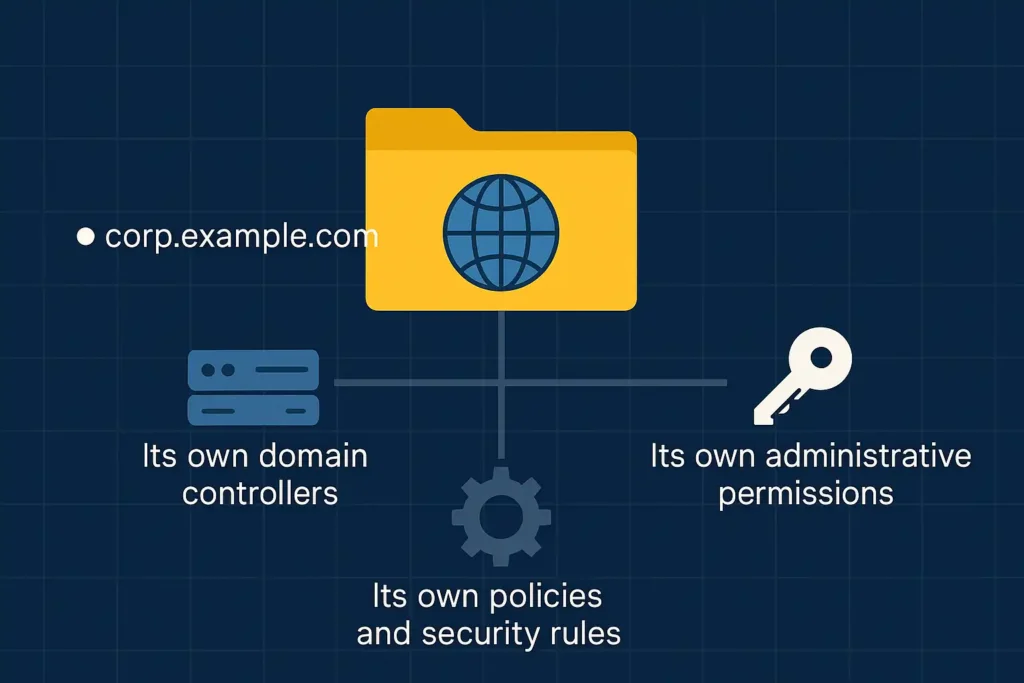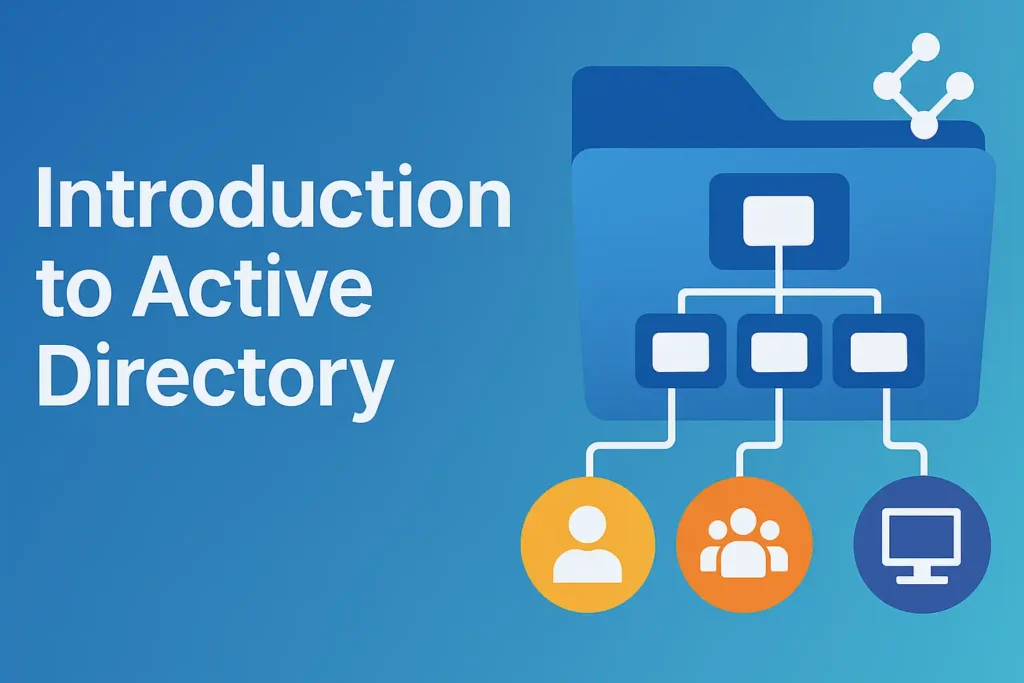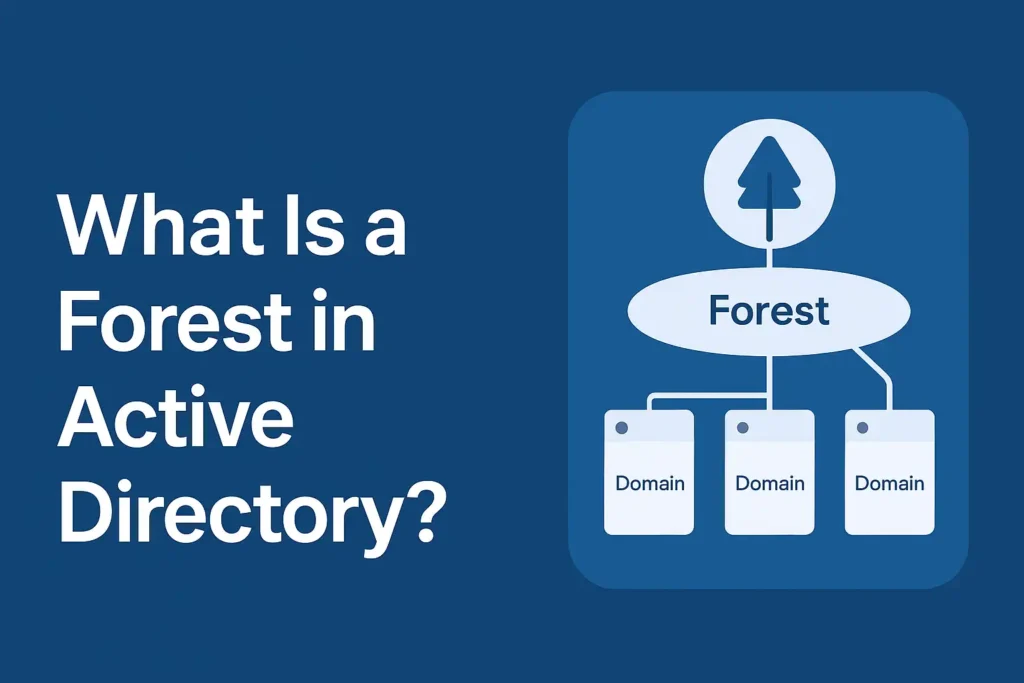What Is a Domain in Active Directory?. Active Directory is one of the most powerful and widely used identity and access management systems in the world. Whether an organization has 50 users or 50,000, AD becomes the backbone that manages user identities, device authentication, security policies, and access to resources. But to truly understand how Active Directory works, you must first understand the building blocks that hold it together.
In the previous articles of this series, we explored the Introduction to Active Directory, where we broke down the purpose of AD, how it is used in modern organizations, and why identity management is the foundation of enterprise security. We also covered What Is a Forest in Active Directory?, where you learned that a forest is the top-level logical structure — the entire kingdom of Active Directory — governing trust relationships, schema, and the overall directory configuration.
Now, we take the next step into the most practical and commonly encountered component of Active Directory: the Domain.
If a forest is the entire world of Active Directory, the domain is the country where day-to-day identity life happens. It is inside domains that users log in, computers join the directory, administrators apply policies, and IT teams manage everything from passwords to access rights.
Understanding what a domain is — and why it exists — is essential before moving into key topics such as Domain Controllers, Organizational Units (OUs), Sites, Replication, and eventually Group Policies.
This article will guide you through:
- What exactly a domain is
- Why domains were created
- How domains manage identity and security
- What objects live inside a domain
- How domains differ from forests
- Real-world examples of domain structures
- Why domains are so important for IT governance
By the end of this post, you will have a clear and confident understanding of what a domain is and how it forms the backbone of every Active Directory environment.
And as always — if you want to continue mastering AD, don’t forget to explore more topics in our Active Directory Series.
This article is the next installment in our Active Directory Series.
If you missed the previous chapters, start here:
Understanding Domains is essential before moving into topics like Domain Controllers, OUs, Sites, and Group Policy. Let’s begin.

What Is a Domain in Active Directory?
What Is a Domain in Active Directory?
A domain in Active Directory is one of the core building blocks of Microsoft’s identity and access management framework. It acts as a logical, administrative, and security boundary that helps organizations organize and control thousands of users, devices, groups, and applications in a structured way.
You can think of a domain as the home where all identity objects live and operate under a single set of authentication and security rules. It provides a unified environment where administrators can centrally manage logins, enforce policies, delegate administrative rights, and secure access to resources such as file shares, printers, and applications.
A domain is essential for any Windows-based enterprise network because it standardizes how identities are created, authenticated, and governed. When a user signs in to their computer, accesses a shared folder, or tries to join a device to the network, the domain defines how their identity is verified and what they’re allowed to do.

Every Domain Contains the Following Core Elements
1. A Unique DNS Name
Every domain has a DNS-based name such as:
corp.example.comthepoemstory.localcontoso.com
This DNS name not only identifies the domain on the network but also forms part of user login identities—for example:john.doe@corp.example.com
2. Its Own Domain Controllers
A domain is powered by one or more Domain Controllers (DCs)—the servers responsible for storing the AD database and processing all authentication requests.
Domain Controllers handle:
- User logins
- Password changes
- Group membership validation
- Kerberos and NTLM authentication
- Policy delivery (via Group Policy)
Without domain controllers, a domain cannot function.
3. Its Own Policies and Security Rules
Each domain maintains its own:
- Password policies
- Account lockout rules
- Group Policies (GPOs)
- Access control models
- Authentication settings
This means different domains in the same forest can still have unique security configurations based on business requirements.
4. Its Own Administrative Permissions
A domain is also a boundary for administrative authority.
Inside a domain, administrators can:
- Create and manage user accounts
- Deploy Group Policies
- Control access to resources
- Delegate administrative rights to specific teams
- Manage security and compliance settings
This separation of duties makes domains especially useful in large organizations with multiple regions, departments, or business units.
Why This Matters
Domains provide structure.
They define who can log in, what they can access, and how security is enforced. Without domains, IT environments would be chaotic, inconsistent, and insecure.
Whether your organization manages 50 employees or 50,000, a domain ensures that identity management stays organized, centralized, and secure.
Why Do Domains Exist?
Domains exist because managing identities, devices, and security at scale requires structure, consistency, and centralized control. Without domains, every computer and user in an organization would have to be managed individually—making the environment unmanageable, insecure, and prone to configuration errors.
A Domain provides a single, unified framework through which organizations can authenticate users, enforce security policies, delegate administrative responsibilities, and protect their resources. It transforms a large, complex network into a manageable and secure system.
Here’s why domains are essential:
1. Centralized Authentication for All Users and Devices
In a domain, every user logs in using a single identity that is stored and managed centrally.
This means:
- One username and password works across the entire network
- Password policies and MFA can be enforced consistently
- User credentials are validated by trusted Domain Controllers
- Authentication is secure, standardized, and traceable
This eliminates the chaos of local accounts and ensures that identity management remains consistent across thousands of systems.
2. Centralized Policy Enforcement Across the Domain
Domains allow administrators to apply security and configuration policies through Group Policy Objects (GPOs).
These policies can control:
- Password complexity
- Software installation
- Firewall and security settings
- Desktop and user environment configuration
Instead of touching each machine individually, administrators can push changes across hundreds or thousands of devices instantly.
3. Delegated Administration Without Losing Control
Domains allow IT teams to delegate specific administrative responsibilities—securely and precisely.
For example:
- Helpdesk teams can reset passwords
- HR teams can manage user data updates
- Department admins can manage their own groups and resources
All of this is done without granting full Domain Admin rights, maintaining strict control and reducing security risk.
4. Strong Security Boundaries for Access Control
A domain creates a clear security boundary that defines:
- Who can log on
- What they can access
- What permissions they have
- How authentication and authorization are enforced
This boundary ensures that users can access only the resources they’re allowed to, protecting sensitive data and reducing attack surfaces.
In Short
Domains exist to ensure that large IT environments remain:
- Organized
- Secure
- Standardized
- Efficient to manage
- Scalable for future growth
They are the backbone of identity and access management in any Windows-based enterprise.
Key Characteristics of a Domain
1. Unique DNS Name
Each domain uses a DNS-style name such as thepoemstory.local or corp.contoso.com.
This same name becomes part of user logins: username@corp.contoso.com.
2. Security Boundary
A domain defines where authentication, authorization, and policies apply. Objects inside the domain follow its security rules.
3. Administrative Boundary
Domains can have independent administrators and separate group policies. This makes them extremely useful in large organizations.
4. Domain Controllers
A domain is powered by Domain Controllers (DCs)—servers responsible for authentication, replication, directory queries, and policy processing.
What Objects Exist Inside a Domain?
A domain organizes the following identity objects:
- Users
- Computers
- Groups
- Organizational Units (OUs)
- Service and application accounts
- Shared resources like printers and file servers
All these objects follow the policies and authentication rules of the domain.
Forest vs Domain: What’s the Difference?
| Forest | Domain |
|---|---|
| The complete Active Directory environment | A subdivision within the forest |
| Defines global structure, schema, and trust | Defines local authentication and policy boundaries |
| Only one forest per deployment | One or multiple domains can exist in a forest |
Analogy: A forest is a city; each domain is a district with its own rules and administrators.
Real-World Examples of Domains
Single Domain Environment
Common in small and medium businesses:
corp.thepoemstory.com
Multi-Domain Environment
Used by large enterprises for regional or departmental separation:
apac.company.comemea.company.comamer.company.com
Why Domains Matter
Domains form the backbone of identity and access management. They are necessary for:
- Group Policy (GPOs)
- Resource access and permission control
- Security boundaries
- Delegated administration
Explore More in Our Active Directory Series
This guide is part of a full step-by-step lear


